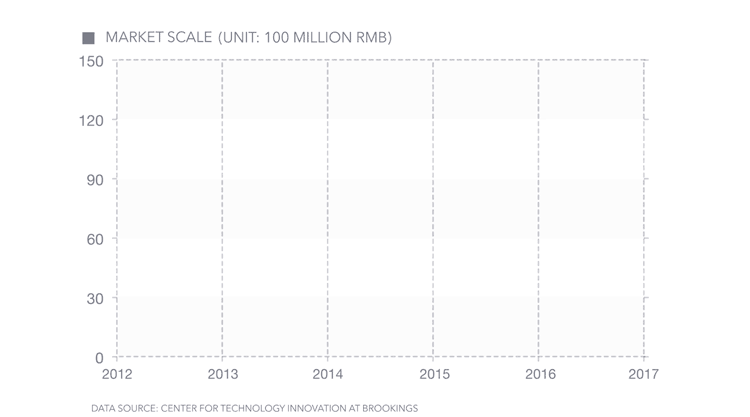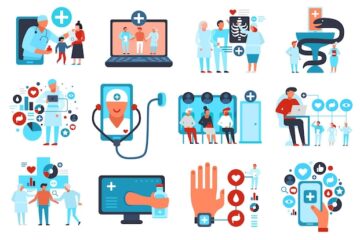Editor’s note: This series was written by Federico Sferrazza, digital marketing manager at Daxue Consulting, a market research company based in China. The images were created by Kevin Maher, co-founder of information design agency Diatom. Part 1 looks at the current problems with China’s healthcare. Part 2 will analyze how current technologies, particularly mobile medical healthcare, will help alleviate many of these issues.
Mobile technology, social media, and e-commerce seem to dominate the conversation when it comes to digital technology in China. The healthcare industry, which traditionally lags in digital innovation relative to its peers, ranks among the least innovative sectors. New technologies pose a significant challenge for the healthcare sector, but also represent a tremendous opportunity for innovation and individualization of treatment to suit patients’ needs. Progress in digital technology has already left a radical mark on Chinese consumer behaviors and lifestyles; the healthcare industry should follow suit by moving quickly to embrace digital innovations. Private digital investment in the health industry reached $1.4 billion for the first semester of 2016, surpassing total investment in 2015. With a revolution off the table for now, here’s how mobile medical healthcare can help with China’s increasing medical problems:
mHealth market

The mobile medical industry (mHealth) has already become a global focus, but in China, it might be one of the greatest healthcare breakthroughs of the year. In 2016, the Chinese mHealth market was valued at 7 billion RMB and is projected to exceed 10 billion RMB by 2017, with a forecasted growth rate of 74.5%. The Chinese mHealth applications market has ballooned in the last five years, drawing a crowd of start-ups and investors. So far, these mobile healthcare apps mainly provide basic functions. Self-diagnosis and medical examination make up only 8% of the market; information searches account for only 6%. Although the mobile healthcare applications market is still nascent, it is expected to soon play an important role in the Chinese healthcare market.
The marriage of digital technology and healthcare to improve individualized care is the biggest opportunity in mHealth.
Three Challenges:
QUALITY: The demand for efficient medical information sharing is increasingly significant. Electronic prescriptions can help reduce errors–such as duplicate medical tests–in healthcare processes and provide patients with the right prescriptions and treatment for their condition. If doctors can accurately prescribe medication electronically, patients could save money otherwise spent on unnecessary prescriptions and treatments.
ACCESS: In China, patients often find obtaining appropriate medical care a difficult process. mHealth has the potential to provide widely accessible services that can be individually tailored and easily adopted. Patients in isolated communities can receive medical attention in the form of early stage diagnosis and treatment through video chats, and conferences, a revolution in accessibility EY reports more than 50% of respondents saw as being important or very important. The most active consumer group in the healthcare market, patients between the ages of 25 and 34, responded overwhelmingly in favor of mobile healthcare.
COST: Mobile devices could make healthcare more affordable, especially for rural patients. Mobile healthcare apps are most widely used by citizens of low education and low income in major urban areas. Over 26 percent of mobile healthcare users earn less than 1999 RMB per month (equal to about $287). One possible motivation for consumers maybe the expected savings of self-diagnosis through apps like Kanchufang, and pre-research before consulting.
- Trend 3: Digital insurance

Although China’s insurance industry is hundreds of years old, it has only been during the last decade that the industry has witnessed significant growth. With the advent of digital technology, the industry pivoted and moved in an entirely new direction. While the idea of risk sharing appeared over 2000 years ago in the time of Confucius, formal insurance systems were not set up until the 1980s, due to unique circumstances facing China. Remarkably, after only 30 years, China’s insurance market is now the third largest in the world.
China’s insurance industry continues to flourish. Digital insurance, the combination of traditional insurance practices and novel technology, including digital distribution, Big Data, and blockchain, has experienced a global boom over the last five years. Subsequently, China’s digital insurance industry has seen rapid growth, with a robust offering of products and providers to satiate demand. The digital insurance market for S1 2015 was 81.6 billion RMB, which represents 260% growth YoY according to the Insurance Association of China. In 2020, digital insurance in China has a projected share of 24%, which is equivalent to 912 billion RMB ($136 billion). One factor that fuels the growth of digital healthcare in China is the rise of the private insurance option due to consumer dissatisfaction with public insurance plans. According to a report from EY, 93% of respondents are not entirely satisfied with their insurance coverage and 33% of them have no savings set aside to cover serious illnesses. The Chinese government downsizing of regulatory barriers and added tax incentives have been a boon for the digital health industry, now equipped with strategic opportunities for growth. Indeed, the private insurance industry is in the early stages of a technology-driven disruption.
- Trend 5: Pharmacy Market Overview

China is the world’s second largest pharmaceutical market, and is forecasted to grow from $108 billion in 2015 to $167 billion by 2020, representing an annual growth rate of 9.1 percent. Pharmaceutical sales currently amount to 17 percent of total health expenditures, or $78 per person. In terms of the market breakdown, generics dominate with a hefty 64 percent of total sales. The pharmaceutical industry–whose wares include synthetic chemicals, Chinese medicines, medical devices and instruments, drugs, hygiene materials, packing materials and pharmaceutical machinery–is one of the leading industries in the People’s Republic of China. About 50.0% of industry revenue was generated through the sale of prescription drugs in 2016, a product whose consumers are mostly senior citizens. The majority of prescription drugs were only launched into the market within the past five years. They are generally more expensive than non-prescription drugs, which means higher profit margins. However, China’s OTC market is also growing quickly—around 17 percent per annum in recent years—according to the China OTC Association’s statistics, and faster than anywhere else in the Asia-Pacific region. At this rate, observers at Espicom expect China to become the world’s largest OTC market by 2020. Although OTC drugs only account for a minority of the Chinese pharmaceuticals market, an increase in OTC sales has already shifted their proportion of sales relative to prescription drugs. A survey conducted by IMS Health in 2010 revealed 53 percent of respondents preferred to self-treat using OTC drugs purchased at the pharmacy or supermarket. More people are choosing to treat themselves rather than go to the hospital for relatively mild symptoms, such as influenza and mild intestinal disorders, thereby raising demand for OTC drugs.
China’s population growth and increasing medical needs make it the world’s biggest producer and exporter of pharmaceutical ingredients. Covering 40% of global APIs production, huge opportunities for growth face the Chinese pharma market. With government’s progressive investment in healthcare and R&D, the Chinese industry is clear to innovate and collaborate with domestic and international pharmaceutical companies.
- Trend 6: ePharmacy Sales

Pharmaceutical E-commerce has entered the development stage, aided by gradual policy decontrol, although the young industry’s development speed is slower than that of other commodity E-commerce. The number of e-pharmacies increased from 28 (2011) to 387 (2016) due to a rise in mobile connectivity. Meanwhile, China’s online medical system is flourishing. From 1.6 billion RMB sales in 2012, a staggering increase to 10.06 billion RMB in 2015 has been reported, which manifested a 58.9% growth compared to 1.6 billion RMB in sales in 2012.
Authorities are considering online prescription drug sales, which would certainly bolster e-commerce firms such as Alibaba and JD.com with new entry points to the lucrative prescription drug business. The E-Pharmacy business in China is quickly changing as new regulations and various competitors enter the space. Online pharmacies are working with hospitals and local governments on separate trial programs to allow patients to buy drugs online with a doctor’s prescription.
Access to prescriptions is critical for online pharmacies attempting to tap into the prescription drug market. Some local trials have managed to extend medical insurance coverage to online medicine purchases, a key incentive for patients to buy online. But analysts are cautiously optimistic about potential trials nationwide, given that China’s social security system is still managed by fragmented jurisdictions, creating discrepancies in coverage policies across the country.
Another challenge for authorities is the task of capping online expenditures. Under the current scheme, the cap for insurance coverage has been maintained by hospitals that prescribe drugs. Online pharmacies cannot thrive in the prescription drug business alone. Given the importance of access to doctors’ prescriptions, retailers need to penetrate upstream.
When the share of drugs in the network/online terminal increases from 10 billion RMB to 150 billion RMB, it will account for 10% of the entire market, thereby enabling pharmaceutical E-commerce to enter a new stage of development. Based on this forecast, we optimistically estimate that by 2020 the pharmaceutical E-commerce market could reach nearly 400 billion RMB in sales.
Conclusion
mHealth has the potential to transform healthcare delivery and improve the quality of care and patient outcome. By leveraging the telecommunications revolution, the ubiquity of mobile “smart” devices and extant IT infrastructure, mHealth can render healthcare more effective, efficient and cheaper. However, there are obstacles for mHealth. Outdated laws and regulations, fractured authorizing environments, inadequate financial reimbursement models and poorly integrated systems will need to be addressed if the full potential of mobile health is to be realized.
The ubiquity of mobile telecommunications has been deemed by many to have the potential to revolutionize healthcare delivery on the global scale. In China, rapid developments to mobile infrastructure and capabilities, along with the development of innovations that apply mobile technology to the practice of medicine and public health, comprise a launch pad for mHealth. Mobile health (mHealth) innovations may be particularly important as China continues to undergo a rapid epidemiological transition, such that the long-term prevention and management of chronic non-communicable diseases (NCDs) has become a widely recognized clinical and public health priority. China recognizes the need to reform its health system in order to keep significant progress made in population health improvements over the last several decades and to tackle the new challenges of NCDs.
The changing face of health care needs and provision in China presents several challenges; mHealth could potentially transform how these challenges are dealt with. This potential can only be realized with a strategic approach to developing and implementing mHealth innovations to strengthen health systems, backed by high-quality evidence of the benefits and value of such approaches.
[Source:-Tech node]




